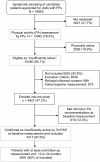Predictors of long-term change of a physical activity promotion programme in primary care
- PMID: 24491081
- PMCID: PMC3933198
- DOI: 10.1186/1471-2458-14-108
Predictors of long-term change of a physical activity promotion programme in primary care
Abstract
Background: Further research is needed to improve the evidence regarding determinants of physical activity (PA) as a crucial step to plan higher effective intervention strategies. The goal of the present study is to identify socio-demographic and clinical characteristics of primary care (PHC) insufficiently active patients that are associated with longitudinal changes in the level of physical activity.
Methods: Longitudinal analysis of baseline socio-demographic and clinical predictors of physical activity change in insufficiently active PHC patients who participated in a PA-promoting multi-centre randomized clinical trial conducted from October 2003 through March 2006. The primary outcome measure was the self-reported physical activity assessed with the 7-day Physical Activity Recall (PAR), at baseline, 6, 12 and 24 months. Baseline covariates included sex, age, social class, anthropometric measures and other cardiovascular risk factors or associated diseases (Diabetes, HTA, tobacco use, etc.), and stage of readiness to change PA. Generalized linear mixed models were used to estimate longitudinal association of studied variables on PA change over the three follow-up measurements.
Results: A total of 3691 patients (85% of the 4317 recruited in the trial) with at least one follow-up measurement were included in the longitudinal analysis. At baseline, analysed patients (mean age: 50.6 years; 64.6% women) devoted 34.7 minutes and 2.36 metabolic equivalent hours per week (MET.h/week) to moderate and vigorous physical activity. Older age, male gender, higher social class, lower BMI, diagnosis of diabetes or hypertension, and measurement season were significant predictors of PA longitudinal change. The effect of baseline readiness to change on PA dose was modified by time, showing a positive gradient in favour of those with more readiness to change that increases significantly at 12 and 24 months (p-value interaction < .0001).
Conclusions: Identified baseline characteristics such as readiness to change and risk factors can guide physicians to prioritize time and intervention efforts for maximizing their impact on insufficiently active PHC patients.
Figures
References
Publication types
MeSH terms
LinkOut - more resources
Full Text Sources
Other Literature Sources
Medical
Miscellaneous



